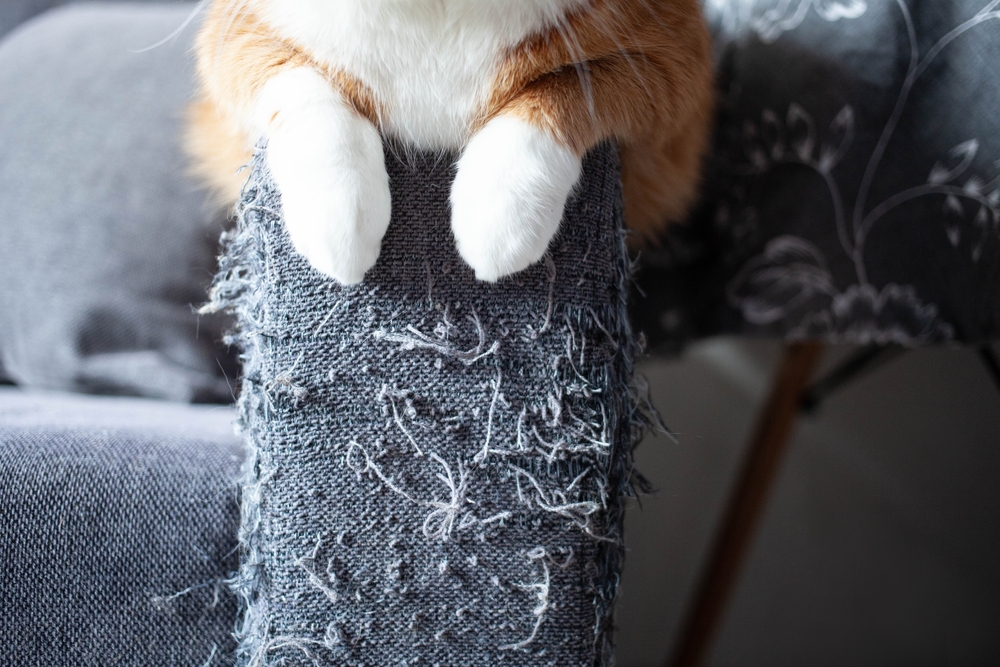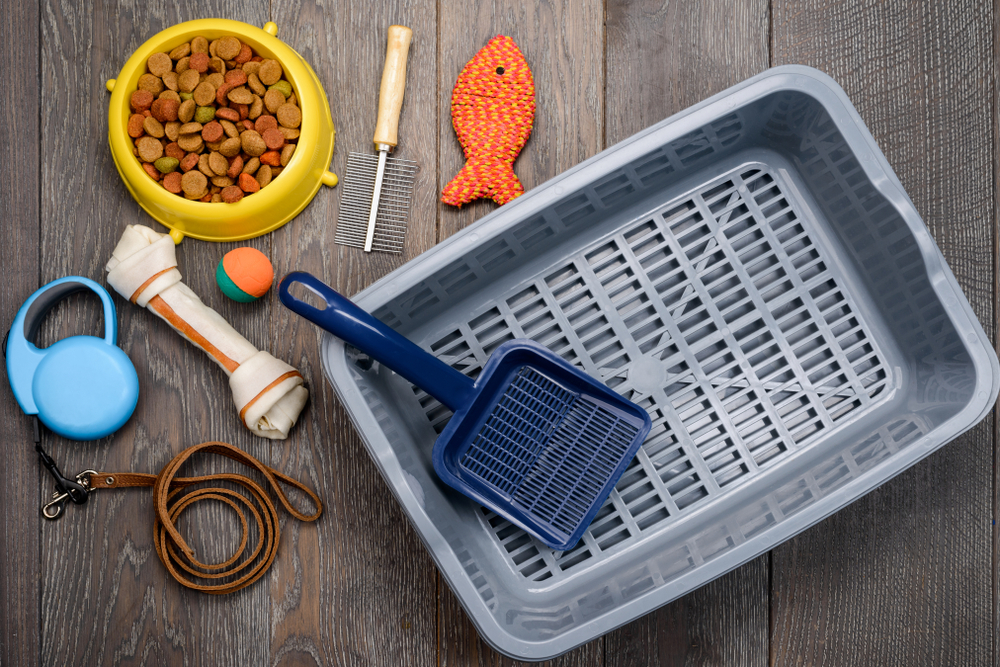Few things can be as fun and exciting as bringing a new pet into your home… except maybe pet-proofing that home!
But the truth is that this entire experience can also lead to fear, especially if you’re dealing with a canine who hasn’t been trained. Whether you’re adopting a new puppy or a dog that’s a few years past his prime, there’ll be an adjustment period. The first thing to remember is that dogs are curious beings.
And that can lead to lots of mischief. That’s the point where they’ll uncover hazards and potential dangers throughout your entire house. So, as a responsible pet owner, you’ll want to prepare by pet-proofing and creating a sanctuary for your new furry pal. The main goal here is to pet-proof your home and make it a safe environment for your pooch by eliminating as many risks as possible.
This isn’t unlike what parents go through when they have a curious toddler in the house: Whether their own or a guest, we’ve all witnessed the mad scramble to move anything fragile or sharp from within mere inches of the floor. It’s just like that; the only difference is that this curious toddler can climb and jump with greater agility than your average toddler.
Your new pup will want to check every nook and cranny, top to bottom. And this is instinctual. They’re drawing on genetic knowledge for secret rewards and hidden dangers. In a pack situation, it’s up to the dog to find all possible elements as quickly as possible in case a dangerous situation appears.
What can he defend, and from what position? What are the escape routes? Is there a secret stash of food hidden somewhere? Canines are born looking for what they need to survive. And that need gives them excellent investigative qualities. They draw on their superior senses to locate anything that might help them survive.
Until your new pet fully acclimates to his new home, he will always look for more, just in case. So, it’s your job to ensure you’ve removed anything perilous. But absolute safety is not possible. The greatest danger is the unforeseen one.
That’s where I come in! I want you to be aware of all the pitfalls you might not have considered. So, on that note, continue reading for the ultimate pet-proofing guide to ensure your new furry pal is as safe as possible in your home!

Pet-proofing your bathroom
Try to keep your bathroom door closed at all times. Pets drinking from the toilet bowl is the obvious threat most people worry about. But there are a few other issues to consider in this room as well. Your pet can eat or chew on cotton swabs, soap, razors, or other sanitary products that are within reach.
Eating dental floss is a leading cause of intestinal problems for dogs, for example. Again, the best approach to pet-proofing is for you and your family members to be aware and clean up after themselves after using the bathroom. Use the under-sink cabinet and medicine cabinet to store things. Keep soaps, towels, and toilet paper neatly organized and out of the way.
Tidiness is the secret here. Don’t forget to put your toilet lid down after each use. Drinking from the bowl isn’t just unsanitary. A young pup can leap into the toilet bowl and drown. For the bathroom trash can, upgrade to one that has a closeable lid. Or you can stash it under the sink and close the door.
Don’t forget that many bathroom items have electrical cords, too. Put away all electrical products, and don’t leave any cords dangling. Ensure you store all medication safely out of your beloved pet’s reach. If you have a puppy and small kids, consider investing in a medicine cabinet with a lock.
Safety is worth the slight inconvenience to you. And while a lock might seem excessive when you only have a cat, you may be surprised at the ingenuity of a feline who gets a whiff of a fish oil supplement. Remember that it isn’t just the potent, prescription-strength medications that can be dangerous. Acetaminophen and other over-the-counter treatments can be very toxic to your pets, too.
Pet-proofing your bedroom
Now, many would urge you to keep bedrooms off-limits. But seeing as I proudly share my bed with my fluffball, I’ll leave that decision to you. Why do people advise against it? Besides the elevated bed position, bedrooms offer lots of chewing opportunities. Remember, canines have a keen sense of smell.
They’re naturally attracted to anything that smells like you and will be compelled to explore. Your shoes, bedspreads, clothing, pillows… pretty much anything that holds your scent will be irresistible to your new furry detective. Shoes are probably the most significant danger found in a bedroom.
Not only are they so chewable that it’s a common pop culture joke but laces can be choking, strangling, and digestive threats. And that’s not a laughing matter. The best defense is keeping the room tidy and putting everything things away in a dresser, hamper, or closet. Coins, pens, and other pocket litter tend to accumulate in the bedroom, too.
Small containers or bins are great for pet-proofing because they can help store all your coins, hairpins, jewelry, and all other small items that can easily be consumed. Pay particular attention to hearing aids or watch batteries.
Try to keep lotions and cosmetics organized and out of the way. They carry strong scents, and the natural ingredients can taste delicious but cause significant illness and upset stomach problems. Many pets like to hide under and behind beds and other furniture, so try to create barriers to prevent them from doing this in your bedroom.
Pet-proofing your kitchen
Food is, obviously, the most common kitchen-related issue potentially. The greatest problem foods are probably cooked chicken bones, chocolate, onions, avocados, coffee, grapes and raisins, macadamia nuts, garlic, and anything that has the sugar-substitute xylitol. But there are others you might not know about, too.
And your dog might have certain types of allergies. So, it’s best to keep all garbage and food locked away on your pet-proofing journey. Other aspects to watch out for are sharp knives and little things like twist ties that can easily be ingested. Also, remember that ovens get hot. And everybody, including your new pet, knows the cleaning products that smell like yummy fruits are under the sink.
Child locks are a fantastic idea whether or not you have youngsters in your home. And you can also install a gate or door to keep animals out of the kitchen while you’re cooking. The number of potential dangers of accidentally being knocked over or falling from the stove is immeasurable.
Pet-proofing your living room
We’ve already established that it’s easy for Fido to find and get into things in your home that they shouldn’t. The living room, as the main living area of your home, offers many easy-to-fix risks. If the living room in your home is anything like mine, cables are the number one problem. In these modern times, everything is powered, and that means everything has a tempting cord hanging from it.
Tempting to pull, grab, and chew. And as we know: Electric cords and chewing NEVER mix. Try to tack your cords to the wall, or at east zip tie them together. You can also place the cords behind furniture where your pet can’t reach. There are also cord keepers that are essentially PVC-like pipes, so they’re not visible.
I use these cable ties I found on Amazon. The main idea here is that the less visible they are, the less tempting they’ll be to chew on. Plants can also be tricky. Pay close attention to plants that might be toxic to your beloved pets. The ASPCA has a list you can check out, but it’s so exhaustive you might just want to move all household plants where your furry pal can’t reach.
They also make a huge mess if knocked over. If you have kids, toys can be found about anywhere. Stepping on a stray building block isn’t the only threat…they can also be a choking hazard for pets. Any toy with small or removable parts can be a problem. In general, you’ll have some ongoing work to do regarding tidiness.
Anything left within reach can become a chew toy for pets, especially younger dogs. And make a household-wide effort to keep the pet’s area clutter-free until you’re sure they’re not likely to grab something and tear it up. Decorative bins can be an easy and affordable solution to many of your hazards in the living room.
Fireplaces also present a huge potential danger. There’s not much you can do but block access to them or any other places where your pup is likely to run into fire, like space heaters or stoves. And don’t leave your pet unattended if you have an open fireplace or space heater. Window dressing cords can also easily be a strangulation hazard.
Be sure to tie them up properly and get rid of any excess cord hanging off. Around the holidays, pay close attention to where you lay out decorations. Not only can many hanging ribbons, ,string lights, and bows be choking hazards, but the chance of losing a beloved family heirloom is not worth taking.

Understanding your pal’s behavior and needs when pet-proofing
Understanding your pet’s behavior, needs, and habits is vital for effective pet-proofing. Different pets have their own unique set of needs based on their age, species, breed, and personality. For instance, cats usually seek high perches and love scratching furniture, while dogs can chew on household items or need more space to run around.
Pay close attention to your pet’s daily activities to pinpoint potential hazards in your home. Do they jump on high surfaces? Are they inclined to chew wires? Tailoring your pet-proofing approaches to your fur baby’s specific preferences and habits will make your efforts more effective and ensure a safer environment overall for them.
Choosing pet-friendly decor and furniture when pet-proofing
When picking out any decor or furniture for your home, consider materials that are easy to clean and durable. Avoid items with small parts and sharp edges that can be chewed off and swallowed.
Opt for stain-resistant fabrics and secure tall furniture to the wall to prevent it from tipping over. Think about your pet’s comfort while you’re at it. A cozy bed or designated resting area can keep them away from furniture and provide them with their own space.
Boundaries and training when pet-proofing
Training is pretty much the most important aspect of pet-proofing. Teach your fluff ball what’s off-limits in your home. This might involve training them to avoid certain pieces of furniture or entire rooms.
Consistency is key during this process, as pets thrive on clear boundaries and routine. Positive reinforcement, like praises and treats, can effectively stimulate good behavior.

Creating a safe outdoor space when pet-proofing
If you’re a pet owner with outdoor spaces, ensuring these areas are just as safe as the indoors is crucial when you’repet-proofing. Begin by walking around and inspecting the perimeter of your yard for weaknesses or gaps in the fencing. Think about the height of the fence in comparison to your pet’s size and jumping ability.
Remove any toxic plants you may have in your garden, and be careful with garden products like pesticides and fertilizers, which can hurt pets. Provide a sheltered area for them to escape severe weather conditions, and always have fresh water available to discourage dehydration. And make sure you regularly check the outdoor area for hazards like holes, sharp objects, or other dangers.
Should you use a crate for your dog when pet-proofing?
The crate can help adapt your pet to its new environment. At the very least, you can use it to constrain your pup when you have guests over.
You may even prefer to have your dog sleep in his crate at night. You can also use this pet-proofing method as a training tool. Whatever the case, a crate can be helpful when bringing your dog home.
Pet-cleaning routines and regular maintenance when pet-proofing
Even though I know this pet-proofing tip sounds like a lot of work, maintaining a clean and orderly environment is essential for your pet’s overall health. Regular grooming, depending on your pet’s needs and breed, can significantly reduce the presence of allergens and shedding.
Try to set a routine for cleaning your pet areas, including litter boxes, bedding, and feeding bowls. Wash your pet’s toys and accessories on a regular basis to contain the buildup of germs and bacteria.
Having a specified area for your floof to eat can minimize all the added mess and it’ll also make cleanup easier. Remember: A clean home is more pleasant to live in and lowers the risk of accidents and health issues for both humans AND their pets!

Common mistakes when pet-proofing and how to avoid them
At the end of the day, pet-proofing your home isn’t an exact science. So, the best thing to do is be as prepared as possible to avoid damage to your pet and home. On that note, I came up with a quick list of some common mistakes new pet owners make regarding pet safety and how to avoid them when pet-proofing your home.
-Think of your pet as a child: Your new furry pal may not have opposable thumbs, but it can certainly have the determination to get where it isn’t supposed to be. So, make sure you go above and beyond by adding barriers to items and areas you need to keep secure.
-Underestimating your pet: When you think you’re done with pet-proofing your home, you’re probably only about halfway done. Younger pets, especially, are curious and will surprise you constantly with what they can get into and how often they can unknowingly put themselves in harm’s way.
-Don’t ignore your pet’s animal instincts: It can be frustrating to find your cat scratching at furniture or a puppy chewing on pillows, but these are instincts that you shouldn’t overlook. Just try to redirect this behavior by providing them with chew toys and scratching posts rather than trying to fight it. You can also consider a trainer if you continue to run into issues.
I hope you found this article on pet-proofing helpful. Be sure to leave a comment and let me know if you think I missed anything. Meanwhile, Pet Compilation has many more fantastic reads for you. You should also check out: 11 Common Dog Mistakes That Slowly End Your Furry Pal’s Life, According to Vets












